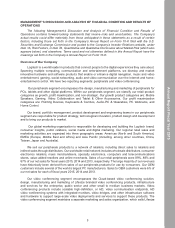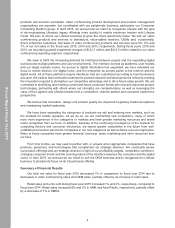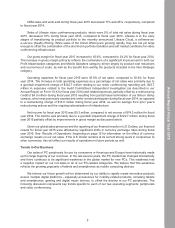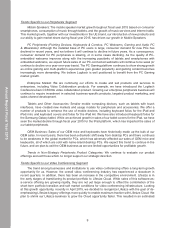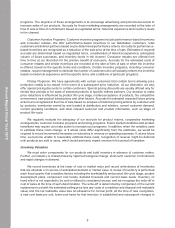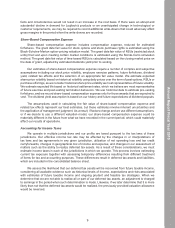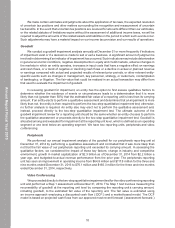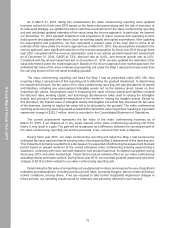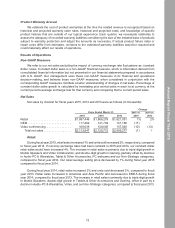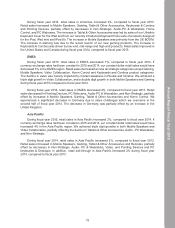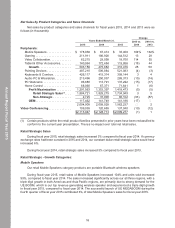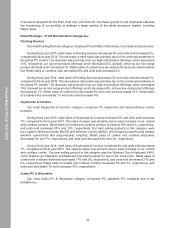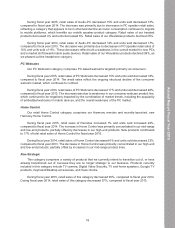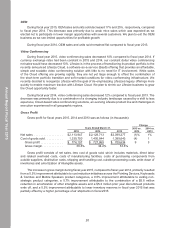Logitech 2015 Annual Report Download - page 128
Download and view the complete annual report
Please find page 128 of the 2015 Logitech annual report below. You can navigate through the pages in the report by either clicking on the pages listed below, or by using the keyword search tool below to find specific information within the annual report.
As of March 31, 2015, taking into consideration the video conferencing reporting unit’s updated
business outlook for fiscal year 2016 based on the factors discussed above and the risk of execution of
its refocused strategy, we updated the future cash flow assumptions for the video conferencing reporting
unit and calculated updated estimates of fair value using the income approach. In particular, we lowered
our December 31, 2014 goodwill impairment test projections of future revenue and operating income
(loss) growth and adjusted other factors (such as working capital and capital expenditure). After updating
the assumptions and projections, we then calculated a present value of the cash flow to arrive at an
estimate of fair value under the income approach as of March 31, 2015. Key assumptions included in the
income approach were significant reduction in the revenue assumption for fiscal year 2016 through fiscal
year 2021 compared with the revenue assumption used in our annual goodwill impairment assessment
as of December 31, 2014, CAGR at 7.2%, discount rate at 14.0%, and terminal growth rate at 4.0%.
Consistent with the annual impairment test on December 31, 2014, we also updated the estimates of fair
value determined under the market approach. Based on the income approach and market approach, the
estimated fair value of the video conferencing reporting unit under the Step 1 assessment was lower than
the carrying amount of the net asset including goodwill.
The video conferencing reporting unit failed the Step 1 test as prescribed under ASC 350, thus
requiring a Step 2 assessment of this reporting unit to determine the goodwill impairment. In determining
the impairment amount, the fair value of the video conferencing reporting unit was allocated to its assets
and liabilities, including any unrecognized intangible assets not on the balance sheet, based on their
respective fair values. Assumptions used in measuring the value of these assets and liabilities included
the discount rates, working capital, and technology obsolescence rates used in valuing the intangible
assets, and pricing of comparable transactions in the market in valuing the tangible assets. Based on
this allocation, the implied value of intangible assets and tangible net assets fully absorbed the fair value
of the business, leaving no implied fair value left to be allocated to the goodwill. The video conferencing
reporting unit’s carrying value of goodwill exceeded the implied fair value of goodwill, resulting in a goodwill
impairment charge of $122.7 million, which is recorded in the Consolidated Statement of Operations.
The current assessment represents the fair value of the video conferencing business as of
March 31, 2015. If we dispose all or any equity interest of the video conferencing reporting unit in the
future, it may result in a gain. The gain will be recognized as a difference between the carrying amount of
the video conferencing reporting unit and the proceeds, if any, received from such a disposal.
During fiscal year 2013, our video conferencing reporting unit failed the Step 1 test because the
estimated fair value was less than its carrying value, thus requiring Step 2 assessment of this reporting unit.
This impairment primarily resulted from a decrease in the expected CAGR during the assessment forecast
period based on greater evidence of the overall enterprise video conferencing industry experiencing a
slowdown, combined with lower demand related to new product launches, increased competition during
fiscal year 2013, and other market data. These factors had an adverse effect on our video conferencing
operating results and future outlook. During fiscal year 2013, we recorded goodwill impairment and other
charges of $214.5 million related to our video conferencing reporting unit.
Determining the fair value of a reporting unit is judgmental in nature and requires the use of significant
estimates and assumptions, including revenue growth rates, operating margins, discount rates and future
market conditions, among others. If we are required to take further substantial impairment charges in
future periods, our operating results would be materially and adversely affected in such period.
12
Annual Report Fiscal Year 2015



